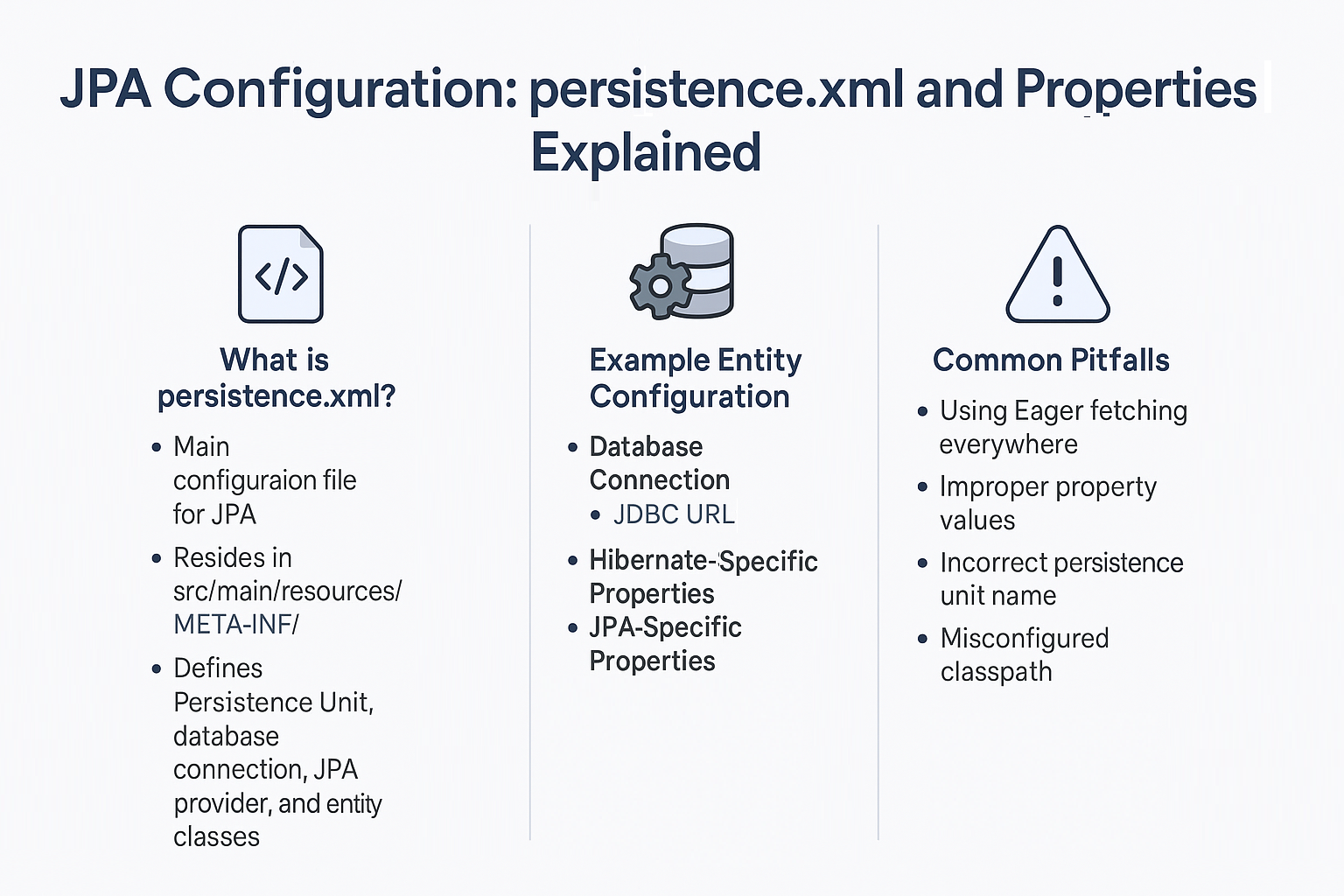Configuring JPA (Java Persistence API) properly is the foundation for building scalable Java applications. Whether you’re using Hibernate, EclipseLink, or OpenJPA, the configuration lies at the heart of how your application communicates with the database. The central piece of this setup is the persistence.xml file, along with optional JPA properties for fine-tuning.
In this tutorial, we’ll take a deep dive into JPA configuration, explore persistence.xml in detail, explain all key properties, and walk through real-world examples and best practices.
What is persistence.xml?
- The persistence.xml file is the main configuration file for JPA.
- It resides in
src/main/resources/META-INF/. - Defines the Persistence Unit, database connection, JPA provider, and entity classes.
Analogy: Think of persistence.xml as the blueprint of a library — it defines where the books (entities) are stored, how they are cataloged (mappings), and who manages them (provider).
Basic persistence.xml Example
<persistence xmlns="https://jakarta.ee/xml/ns/persistence" version="3.0">
<persistence-unit name="examplePU" transaction-type="RESOURCE_LOCAL">
<class>com.example.model.User</class>
<properties>
<!-- Database Connection -->
<property name="jakarta.persistence.jdbc.driver" value="org.h2.Driver"/>
<property name="jakarta.persistence.jdbc.url" value="jdbc:h2:mem:testdb"/>
<property name="jakarta.persistence.jdbc.user" value="sa"/>
<property name="jakarta.persistence.jdbc.password" value=""/>
<!-- Hibernate Provider -->
<property name="hibernate.dialect" value="org.hibernate.dialect.H2Dialect"/>
<property name="hibernate.hbm2ddl.auto" value="update"/>
<property name="hibernate.show_sql" value="true"/>
<property name="hibernate.format_sql" value="true"/>
</properties>
</persistence-unit>
</persistence>
Key JPA Properties
Database Connection
jakarta.persistence.jdbc.driver→ Database driver class.jakarta.persistence.jdbc.url→ Database URL.jakarta.persistence.jdbc.user→ Database username.jakarta.persistence.jdbc.password→ Database password.
Hibernate-Specific Properties
hibernate.dialect→ Tells Hibernate which SQL dialect to use.hibernate.hbm2ddl.auto→ Schema generation (create,update,validate,none).hibernate.show_sql→ Logs executed SQL queries.hibernate.format_sql→ Pretty prints SQL logs.hibernate.jdbc.batch_size→ Batch size for inserts/updates.
JPA-Specific Properties
jakarta.persistence.schema-generation.database.action→ Auto schema generation.jakarta.persistence.lock.timeout→ Lock timeout in milliseconds.jakarta.persistence.query.timeout→ Query execution timeout.
Example Entity Configuration
import jakarta.persistence.*;
@Entity
@Table(name = "users")
public class User {
@Id
@GeneratedValue(strategy = GenerationType.IDENTITY)
private Long id;
private String name;
@Column(unique = true, nullable = false)
private String email;
// Getters & Setters
}
Relationship Example
@Entity
@Table(name = "orders")
public class Order {
@Id
@GeneratedValue(strategy = GenerationType.IDENTITY)
private Long id;
private String product;
@ManyToOne
@JoinColumn(name = "user_id")
private User user;
}
CRUD Example with EntityManager
EntityManagerFactory emf = Persistence.createEntityManagerFactory("examplePU");
EntityManager em = emf.createEntityManager();
// Create
em.getTransaction().begin();
User user = new User();
user.setName("Alice");
user.setEmail("alice@example.com");
em.persist(user);
em.getTransaction().commit();
// Read
User found = em.find(User.class, user.getId());
// Update
em.getTransaction().begin();
found.setName("Alice Updated");
em.merge(found);
em.getTransaction().commit();
// Delete
em.getTransaction().begin();
em.remove(found);
em.getTransaction().commit();
em.close();
emf.close();
Querying with JPA
JPQL
List<User> users = em.createQuery("SELECT u FROM User u WHERE u.name = :name", User.class)
.setParameter("name", "Alice")
.getResultList();
Criteria API
CriteriaBuilder cb = em.getCriteriaBuilder();
CriteriaQuery<User> query = cb.createQuery(User.class);
Root<User> root = query.from(User.class);
query.select(root).where(cb.equal(root.get("email"), "alice@example.com"));
List<User> results = em.createQuery(query).getResultList();
Native SQL
List<Object[]> results = em.createNativeQuery("SELECT * FROM users").getResultList();
Fetching Strategies
- Lazy (default) → Load only when accessed.
- Eager → Load immediately with parent entity.
Analogy: Lazy loading is like ordering food only when you’re hungry, while eager loading is like ordering the full buffet upfront.
@OneToMany(mappedBy = "user", fetch = FetchType.LAZY)
private List<Order> orders;
Common Pitfalls and Anti-Patterns
- Using Eager fetching everywhere → performance bottlenecks.
- Overusing
CascadeType.ALL→ may cause unintended data deletions. - Ignoring transaction boundaries → inconsistent database states.
Best Practices
- Prefer lazy fetching with selective
JOIN FETCH. - Use DTO projections for read-heavy queries.
- Define indexes at the database level.
- Monitor SQL logs for optimization.
📌 JPA Version Notes
- JPA 2.0 → Introduced Criteria API, Metamodel.
- JPA 2.1 → Added stored procedures, entity graphs.
- Jakarta Persistence (EE 9/10/11) → Migrated from
javax.persistence→jakarta.persistence.
Real-World Integrations
Spring Boot
spring.datasource.url=jdbc:h2:mem:testdb
spring.datasource.username=sa
spring.datasource.password=
spring.jpa.hibernate.ddl-auto=update
spring.jpa.show-sql=true
Jakarta EE
@Stateless
public class UserService {
@PersistenceContext
private EntityManager em;
public void saveUser(User user) {
em.persist(user);
}
}
Conclusion and Key Takeaways
- persistence.xml is the cornerstone of JPA configuration.
- Proper configuration ensures database portability, performance, and maintainability.
- Use properties like
hibernate.show_sql,hibernate.jdbc.batch_sizeto optimize queries. - Stick to lazy fetching, DTOs, and proper transaction management for production systems.
FAQ
1. What’s the difference between JPA and Hibernate?
JPA is a specification; Hibernate is an implementation.
2. How does JPA handle the persistence context?
It tracks entity states like a register, auto-syncing with the database.
3. What are the drawbacks of eager fetching in JPA?
It loads unnecessary data, leading to performance issues.
4. How can I solve the N+1 select problem?
Use JOIN FETCH or entity graphs.
5. Can I use JPA without Hibernate?
Yes, you can use EclipseLink, OpenJPA, or other providers.
6. What’s the best inheritance mapping strategy?
Depends: SINGLE_TABLE (fastest), JOINED (normalized).
7. How does JPA handle composite keys?
By using @EmbeddedId or @IdClass.
8. What changes with Jakarta Persistence?
Namespace moved from javax.persistence to jakarta.persistence.
9. Is JPA suitable for microservices?
Yes, but keep transactions short and use DTOs.
10. When should I avoid using JPA?
For high-performance analytics or NoSQL databases.
